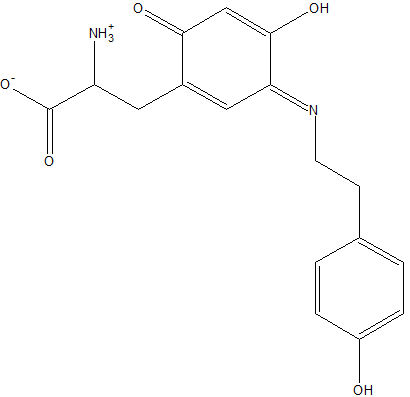Copper Amine Oxidase
From Proteopedia
(Difference between revisions)
| Line 4: | Line 4: | ||
| - | + | {{STRUCTURE_2d1w | PDB=2d1w | SCENE= }} | |
== Structure == | == Structure == | ||
| - | + | ||
| - | 2d1w is a [http://en.wikipedia.org/wiki/Amine_oxidase_%28copper-containing%29 copper amine oxidase] derived from [http://en.wikipedia.org/wiki/Arthrobacter_globiformis Arthrobacter globiformis]. The structure of this enzyme was determined by Murakawa et al. in 2005, by x-ray diffraction<ref>PMID:16487484</ref>. It consists of a homodimer, with each subunit containing 638 residues, one of which is a modified tyrosine residue. Each subunit also contains a copper ligand,<scene name='Sandbox_Reserved_331/Copper_ligand/5'> shown here</scene>, near the active site, which is coordinated by three histidine residues. Located near the Cu<sup>2+</sup> ligand is a cofactor, topa quinone, both of which play a central role in the enzyme's activity<ref>PMID:8591028</ref>. | + | [[Image:TTS.png|right|frame|alt=3-((3E)-4-HYDROXY-3-{[2-(4-HYDROXYPHENYL)ETHYL]IMINO}-6-OXOCYCLOHEXA-1,4-DIEN-1-YL)ALANINE.|Residue 382 is a modified tyrosine residue.]] 2d1w is a [http://en.wikipedia.org/wiki/Amine_oxidase_%28copper-containing%29 copper amine oxidase] derived from [http://en.wikipedia.org/wiki/Arthrobacter_globiformis Arthrobacter globiformis], and is classified as classified as EC 1.4.3.6 in the EC number classification of enzymes. It belongs to the larger class of [http://en.wikipedia.org/wiki/Oxidoreductase oxidoreductases], and is classified under EC1. The structure of this enzyme was determined by Murakawa et al. in 2005, by x-ray diffraction<ref>PMID:16487484</ref>. It consists of a disulfide-linked homodimer, with each subunit containing 638 residues, one of which is a modified tyrosine residue. Each subunit also contains a copper ligand,<scene name='Sandbox_Reserved_331/Copper_ligand/5'> shown here</scene>, near the active site, which is coordinated by three histidine residues. Located near the Cu<sup>2+</sup> ligand is a cofactor, topa quinone, both of which play a central role in the enzyme's activity<ref>PMID:8591028</ref>. The active site of the enzyme is located near the center of the homodimer, which is connected to the outside of the enzyme by an extensively hydrated channel. It is suspected that the water helps to carry O<sub>2</sub> to the active site<ref>PMID:12135347</ref>. |
| - | + | ||
== Reaction == | == Reaction == | ||
| + | === Overview === | ||
Copper amine oxidase catalyzes the oxidation of a primary amine to the corresponding aldehyde, yielding hydrogen peroxide and free ammonia. An example of this is the oxidation of [http://en.wikipedia.org/wiki/Tyramine tyramine]: | Copper amine oxidase catalyzes the oxidation of a primary amine to the corresponding aldehyde, yielding hydrogen peroxide and free ammonia. An example of this is the oxidation of [http://en.wikipedia.org/wiki/Tyramine tyramine]: | ||
[[Image:Tyramine oxidation.png|center|frame|The oxidation of tyramine, yielding the corresponding aldehyde, hydrogen peroxide, and ammonia.]] | [[Image:Tyramine oxidation.png|center|frame|The oxidation of tyramine, yielding the corresponding aldehyde, hydrogen peroxide, and ammonia.]] | ||
| + | === Mechanism === | ||
| + | |||
| + | |||
| + | == Additional Resources == | ||
| + | [http://www.google.ca/url?sa=t&source=web&cd=2&ved=0CB8QFjAB&url=http%3A%2F%2Fwww.jbc.org%2Fcontent%2F271%2F9%2F4718.full.pdf&rct=j&q=Topa%20quinone&ei=lb6UTZyZH8PdiAKF9t39CA&usg=AFQjCNFe66G0M8KGm8HD9rmSgzSyZwi9RQ&sig2=nwPWJNlka1WrmFatRPFH9Q&cad=rja The Biosynthesis of Topa Quinone Cofactor in Bacterial Amine Oxidases] | ||
Revision as of 18:23, 31 March 2011
| This Sandbox is Reserved from January 10, 2010, through April 10, 2011 for use in BCMB 307-Proteins course taught by Andrea Gorrell at the University of Northern British Columbia, Prince George, BC, Canada. |
To get started:
More help: Help:Editing |
Contents |
Structure
2d1w is a copper amine oxidase derived from Arthrobacter globiformis, and is classified as classified as EC 1.4.3.6 in the EC number classification of enzymes. It belongs to the larger class of oxidoreductases, and is classified under EC1. The structure of this enzyme was determined by Murakawa et al. in 2005, by x-ray diffraction[1]. It consists of a disulfide-linked homodimer, with each subunit containing 638 residues, one of which is a modified tyrosine residue. Each subunit also contains a copper ligand,, near the active site, which is coordinated by three histidine residues. Located near the Cu2+ ligand is a cofactor, topa quinone, both of which play a central role in the enzyme's activity[2]. The active site of the enzyme is located near the center of the homodimer, which is connected to the outside of the enzyme by an extensively hydrated channel. It is suspected that the water helps to carry O2 to the active site[3].
Reaction
Overview
Copper amine oxidase catalyzes the oxidation of a primary amine to the corresponding aldehyde, yielding hydrogen peroxide and free ammonia. An example of this is the oxidation of tyramine:
Mechanism
Additional Resources
The Biosynthesis of Topa Quinone Cofactor in Bacterial Amine Oxidases
References
- ↑ Murakawa T, Okajima T, Kuroda S, Nakamoto T, Taki M, Yamamoto Y, Hayashi H, Tanizawa K. Quantum mechanical hydrogen tunneling in bacterial copper amine oxidase reaction. Biochem Biophys Res Commun. 2006 Apr 7;342(2):414-23. Epub 2006 Feb 8. PMID:16487484 doi:10.1016/j.bbrc.2006.01.150
- ↑ Parsons MR, Convery MA, Wilmot CM, Yadav KD, Blakeley V, Corner AS, Phillips SE, McPherson MJ, Knowles PF. Crystal structure of a quinoenzyme: copper amine oxidase of Escherichia coli at 2 A resolution. Structure. 1995 Nov 15;3(11):1171-84. PMID:8591028
- ↑ Mure M, Mills SA, Klinman JP. Catalytic mechanism of the topa quinone containing copper amine oxidases. Biochemistry. 2002 Jul 30;41(30):9269-78. PMID:12135347
Proteopedia Page Contributors and Editors (what is this?)
Michal Harel, Raymond Lyle, Alexander Berchansky, OCA, Jaime Prilusky


